7
TRANSPORTATION AND
EMPLOYMENT
Workforce
An estimated 827,922 people worked full-time in the transportation
sector in 1999, representing 6.9 per cent of total full-time employment
in Canada. This was slightly less than in 1998, when transportation
made up seven per cent. In 1997 and 1996, transportation
accounted for 7.0 and 7.1 per cent, respectively, while in 1995
an estimated 7.2 per cent of full-time employees were directly associated
with the transportation sector.
This report categorizes transportation-related jobs as follows:
- transport services
- transportation infrastructure
- government services tied to transportation
- other associated jobs.
In 1999, transport services accounted for an estimated 614,451
jobs, or 74.2 per cent of the total full-time workforce directly
associated with transportation. Related services, such as marine
pilotage and tour operators, made up 94,600 jobs (11.4 per cent),
while jobs related to the development and maintenance of infrastructure
accounted for 85,600 positions (10.4 per cent). Transport-related
jobs in the federal and provincial governments accounted for the rest
(four per cent).
Keeping in mind that this chapter considers only full-time
jobs directly associated with any segment of the industry, the
trucking industry is the most important employer in the transportation
sector, accounting for 36.5 per cent of all positions. Air
transportation is the second largest employer with an estimated
14.2 per cent of all transport jobs.
Table 7-1 compares employment, by category, for the transportation
industry.
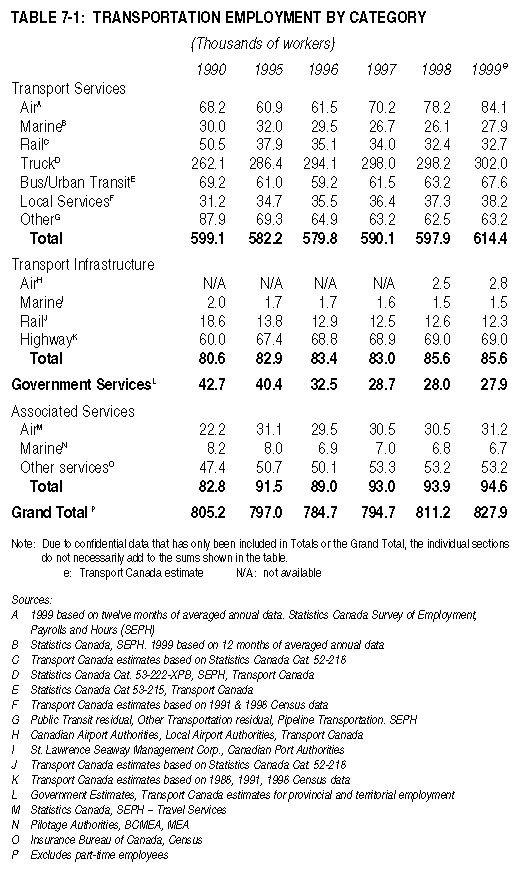
Transport Services
Rail
The numbers for personnel involved in the direct provision
of rail transport services include engineers, conductors and workers
who carry out equipment maintenance, as well as an estimate of
carrier managerial and administration staff allocated to transportation
services.Note
1
The estimated number of people involved in the provision of
rail transportation services dropped significantly in all job
categories between 1990 and 1998 (36 per cent). Equipment maintenance
workers were the most affected, with a 47 per cent decrease.Note
2 Contracting out may have contributed to some
portion of the recent declines, but the number of employees associated
with contract work is not known at the time of writing. In 1998, there
was a 4.5 per cent decline in total personnel employed in rail
transport services, incurred entirely by the Class I
carriers.
Table 7-2 shows employment in rail transportation services,
for Class I, II and III carriers, since 1990.Note 3

Trucking
Medium and Large For-Hire Trucking Firms
In 1998, medium and large for-hire trucking firmsNote 4 employed an estimated
31 per cent of all personnel engaged in trucking activity in Canada.
The total number of employees grew by 0.8 per cent from 1997 levels.
The number of company drivers increased by 2.9 per cent,
while the number of "other" employees dropped by 1.8 per cent.
The number of "other employees" has been fluctuating
since 1995, which may be a function of the survey rather than
a representation of actual industry trends.
Since 1991, company drivers have accounted for approximately
57 per cent of all company employees in medium and large for-hire
firms. This trend held true in 1998, with drivers making up 57.1
per cent of all employees. The range varied from a low of 55.7
per cent in 1995 to a high of 58.2 per cent in 1996.
Table 7-3 shows employment levels at medium and large for-hire
firms for the period 1991 to 1998.
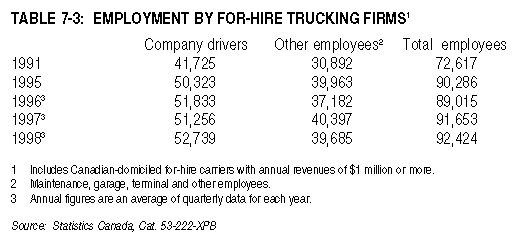
Ontario firms continue to employ the largest proportion of
drivers in Canada, accounting for 40 per cent of all drivers for
large for-hire carriers in 1998. Firms in the Prairie Provinces
and Quebec accounted for 24 and 21 per cent, respectively,
of all drivers for medium to large for-hire companies. The
total number of employees increased in all regions except British
Columbia and the Territories.
Table 7-4 compares employment, by region, for the trucking
industry.
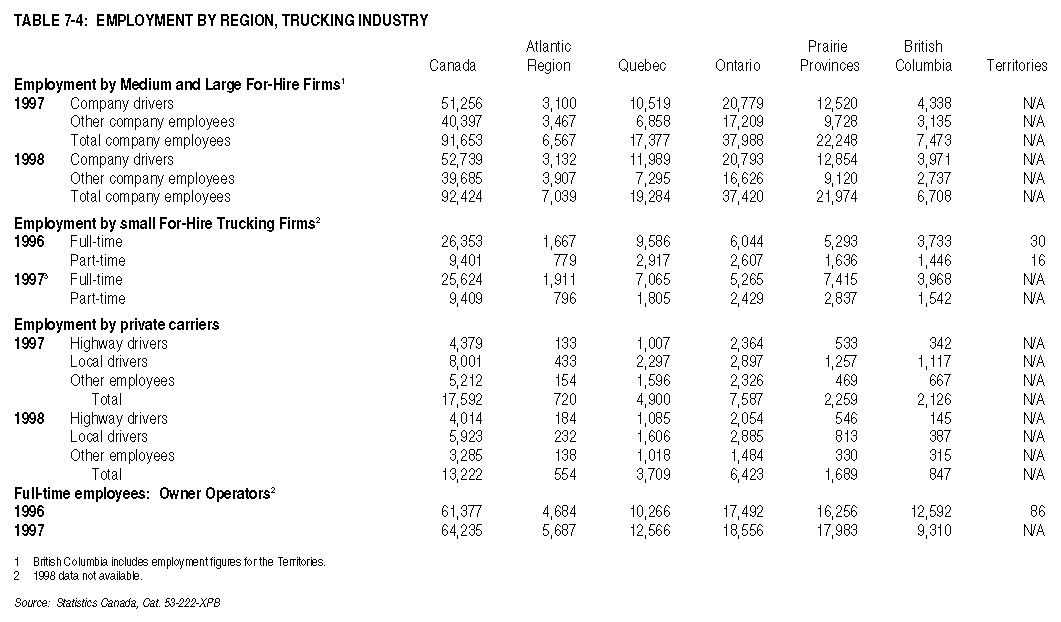
Small For-Hire Carriers
In 1997, the number of full-time employees associated with
small for-hire carriersNote 5 decreased by 2.7 per cent from
1996. While there were large drops in Quebec (26 per cent) and
Ontario (13 per cent), all other regions saw increases: Atlantic,
14.6 per cent; Prairie Provinces, 40 per cent; and British Columbia,
6.3 per cent.
Table 7-4 shows the number of full and part-time workers employed
by the small for-hire trucking industry in Canada.
Private Carriers
In 1998, there were 396 private carriersNote 6 reporting in Canada,
down from 422 in 1997. The number of employees reported by these
carriers also decreased substantially, down 25 per cent. The number
of highway drivers decreased by eight per cent, while local drivers
and "other" employees dropped by 26 and 37 per cent,
respectively. The figures indicate that a number of the private
carriers that did not report in 1998 were involved extensively
in local operations.
In terms of proportional decline, British Columbia and the
Territories had the largest decrease in the number of personnel
employed by private companies, at 60 per cent. The number of employees
in the Prairie Provinces, Quebec and Atlantic Region decreased
by 25, 24 and 23 per cent, respectively. Ontario saw a decline
of 15 per cent.
Table 7-4 shows total employment by private trucking carriers
for 1997 and 1998.
Owner-Operators
In 1997, 40,000 owner-operators employed 64,235 full-time employees.
The largest proportion (29 per cent) was in Ontario.
Owner-operators in the Prairie Provinces were the next largest
group, with 28 per cent of the total employees. Quebec,
British Columbia and the Atlantic Region accounted for 20, 14.5 and
8.5 per cent, respectively.
Table 7-4 shows the number of full-time employees associated
with owner-operators for 1996 and 1997.Note 7
Total Trucking Employment
Total full-time employment in the trucking industry increased
by 1.2 per cent in 1997. While actual data for a number of components
of the industry for 1998 and 1999 are not available, estimates
indicate that the workforce was stable in 1998 and saw a
small increase of about one per cent in 1999. Employment
by medium and large for-hire carriers increased slightly in 1998
(0.8 per cent), while the number of people employed by private
carriers appears to have decreased significantly.
Table 7-5 compares employment, by sector, in the trucking industry
from 1991 to 1998.Note 8

Bus
Employment figures for largeNote 9 intercity and school bus operators
appear to have shifted significantly between 1997 and 1998. In
1998, 14 large intercity carriers reported 1,206 full-time employees.Note
10This was a 60 per cent decrease from the 2,960 full-time
employees reported by 15 large intercity bus companies in 1997.Note
11 Conversely, 91 large school bus companies reported
22,192 full-time employees in 1998,Note 12 a 19 per cent
increase if compared with the 81 large companies that reported
in 1997.Note
13
Employment figures in the charter and other bus industry also
appear to be somewhat unstable, with a 15 per cent decline in
1997 followed by a 22 per cent increase in 1998. In 1996, employment
appeared to have increased by 39 per cent from 1995.
While only two years of employment information are available for
the shuttle services sector, the data also appears unstable, with
a 21 per cent decrease being reported for 1998.
In 1998, 62 urban transit companies reported a full-time compliment
of just under 36,000 employees. This was 1.7 per cent below
employment levels reported for 1997. Between 1990 and 1998, the
number of full-time employees in this sector decreased by five
per cent.
These apparent shifts in the employment numbers can be explained
by a number of factors. Since the mid-1990s, the industry has
gone through a period of consolidation, mergers and acquisitions.
In addition, starting in 1997, data for the bus industry has been
reported according to the North American Industrial Classification
System (NAICS). Under NAICS, companies are classified by industry
according to their main activity, which may change from year
to year. For example, in 1996 there were 43 companies reporting
under SIC 4572 (Scheduled Intercity Bus Industry). Under NAICS
there would have been only 29. Also, because the bus industry
has become more dynamic over recent years, companies are involved
in more than one sector (e.g. intercity, school bus, charter and
shuttle activities).
Table 7-6 shows full-time employment figures for the bus industry
for the period 1990 to 1998.

Taxi and Limousine Services
According to census data, there were 35,490 taxi and limousine
drivers in Canada in 1996, an 18 per cent increase from 1986 levels.
Three provinces accounted for 76 per cent of all taxi and limousine
drivers employed in Canada during 1996. Ontario accounted for
40 per cent of drivers, an increase of 27 per cent from 1986 levels.
Quebec employed 24 per cent, up ten per cent from 1986, while
British Columbia employed 12 per cent, up 16 per cent.Note
14
Marine
Average annual employment in the water transport industry,
including services incidental to water transportation, increased
by seven per cent in 1999 over 1998 levelsNote 15. Historically,
employment has declined by 13 per cent since 1995.
In 1999, 42 per cent of all people working in the water transport
industry, not including services incidental to water transport,
were located in British Columbia. The Atlantic Region accounted
for another 18 per cent, while Ontario and Quebec accounted for
16 and 15 per cent, respectively.
Ferry operations account for a large proportion of employment
in the marine transport services sector, generating about two
thirds of all transportation jobs provided by Canadian-based carriers.
Table 7-7 shows average annual employment in the water transport
sector, by region.
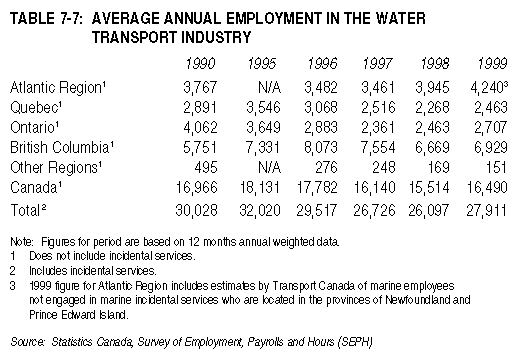
Air
After a decline from 1990 to 1995, employment in the air industry
has grown by 38 per cent between 1995 and 1999. The last two years
saw significant increases: in 1998 and 1999 total employment
grew over 11 and seven per cent, respectively.
Following a significant decline between 1990 and 1995, total
employment by Levels I-III air carriers exceeded 1990 levels
in 1998.Note
16 There were increases in all employment categories.
The number of pilots and copilots and other flight personnel increased
by ten per cent. Management and administration personnel grew
by 11 per cent, and the number of other carrier personnel
increased by just over nine per cent. Employment by Level IV
carriers increased by 25 per cent between 1997 and 1998.
Table 7-8 compares Level I-IV air carrier employment levels
with that of the total air industry.

Other
The "other" public passenger transit employment figures
shown in Table 7-9 refer to personnel employed by public transit
companies not included in the Statistics Canada bus surveys referred
to earlier in this section,Note 17 as well as people directly
employed by services incidental to the bus industry. A significant
drop in employment was noted between 1990 and 1995. Since then,
however, the number of jobs has slowly increased. Based on the
first six months of available data, there was a seven per cent
increase in employment in 1999 from 1998.

The number of personnel employed in "other transportation"
jobs has been steadily decreasing since 1990.Note 18
The number of people employed by the "pipeline transportation"
sector has also been slowly decreasing since 1990, with a further
2.5 per cent decline during 1999. A number of these jobs are probably
associated with the development and maintenance of the pipeline
infrastructure, and as such should be reported in the following
section. It is impossible, however, with any level of
accuracy, to disaggregate the numbers to that level
of detail.
Data Gaps
A number of data gaps exist in transport services. In air,
no employment data is captured for Level V and VI carriers, or
private and general aviation activity. There are no numbers available
for jobs in Canada related to foreign carriers operating to/from
this country. In the marine area, there are no figures associated
with shipping conferences operating in Canada.
Transport Infrastructure
This section refers to personnel employed at harbours, airports,
ports and other transport-related facilities. It also includes
personnel dedicated entirely to the construction and maintenance
of transport infrastructure, such as rail right-of-way, roads
and highways.
Rail
The number of road maintenance workers employed by both
Class I and Class II rail carriers decreased by 33 per cent
since 1990. If the estimated number of managerial and administration
staff are included, employees dedicated to rail infrastructure
declined by 34 per cent for Class I carriers and 32 per cent
for Class II carriers.
Table 7-10 compares the number of people employed in rail infrastructure
services by Class I and II rail carriers between 1990 and 1998.

Highways
There is no definitive source for determining the number of
people employed in the construction and maintenance of highways
in Canada. In addition, this is an industry influenced by economic
and seasonal factors among others. The employment data in this
report are derived from census data for the industry classification
"Highways and Heavy Construction." Actual data was available
for 1986, 1991 and 1996. Estimates for intervening years are derived
from average annual growth between 1991 and 1996.
There were 68,820 people employed under this classification
in 1996. On the assumption that post 1996 employment grew
at the same rate as government expenditures on road construction
and maintenance (0.3 per cent) between 1996 and 1999, there
were an estimated 69,026 people employed under this category in 1999.
Marine
Ports
There were 921 full-time personnel employed by the Canadian
Port AuthoritiesNote
19 (CPA) in 1999, compared with 879 by the same group
of ports in 1998. The number of part-time workers remained stable,
whereas the number of contract workers increased from 56 in 1998
to 85 in 1999.
Table 7-11 shows total employment, by category, by the Port
Authorities in 1998 and 1999.
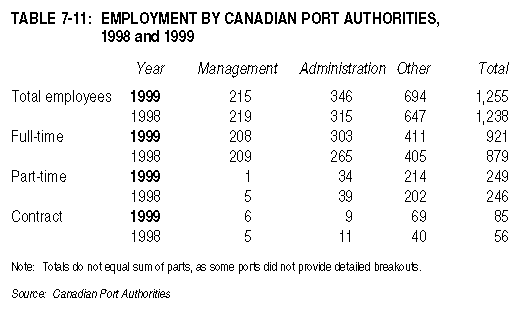
Employment numbers in the summary table (Table 7-1) at the
beginning of this chapter include employment data for Canadian
Ports Corporation (CPC) facilities for the period 1990 to 1997.
As such, the time-series does not refer to the same set of ports.
It is, however, a good indicator of the number of full-time personnel
at Canada's major ports over the reference period.
St. Lawrence Seaway Management Corporation
The number of full-time positions at the St. Lawrence Seaway
Management Corporation (SLSMC) decreased by 8 per cent in 1999,
as compared with the number of employees reported by its predecessor,
the St. Lawrence Seaway Authority (SLSA), in December 1998. Decreases
occurred in all categories, with the largest proportional decrease
(27 per cent) in management. The numbers of administration and
operations staff each decreased by less than 10 per cent.
Table 7-12 summarizes total employment levels at the SLSMC
and SLSA between 1995 and 1999.

Air
In 1999, there were an estimated 2,547 full-time people employed
at Canadian Airport Authorities (CAAs) and Local Airport Authorities
(LAAs) in the National Airport System (NAS). There were also 292 Transport
Canada employees in transit to CAAs.Note 20 Combined, the
2,839 people working at NAS airports accounted for an estimated
12 per cent increase over the number of employees reported in
1998. NAS airports handled over 90 per cent of the passenger
activity at Canada's airports in 1999.
Table 7-13 shows available employment data for Canada's NAS
airports in 1999.

Data Gaps in Transportation Infrastructure
Numerous gaps exist in the reporting of transportation infrastructure
data. Some employment figures are not captured or are impossible
to break out from more aggregate information. With airports, for
example, employment at non-NAS facilities is not identified. In the case
of ports, this report includes only full-time employment at Canadian
Port Authorities, thereby excluding all personnel employed by
non-port authorities and private firms. Various other jobs related
to marine infrastructure, such as dredging, construction and maintenance
of piers, berths and terminals, are not specifically addressed
in this section. Finally, the employment figures reported for
construction and maintenance of highways may be high, as it is
impossible to break out the number of workers employed in heavy
construction.
Government Services Tied to Transportation
Federal Government Services
In 1999/2000, five federal departments and agencies have planned
to devote 8,297 full-time employees to transportation.Note 21 This was a 1.6
per cent decrease from planned levels in 1998/99. These numbers
do not include positions primarily concerned with transportation
in other departments and agencies, such as Revenue Canada/Customs
and Immigration, the federal police, Agriculture Canada, Heritage
Canada and the National Capital Commission, for example. While
some departments and agencies have some transport-related functions,
the employment figures are not captured at a level of detail that
allow identification of the associated jobs.
Table 7-14 shows planned full-time equivalentsNote 22 in federal departments
and agencies that deal directly with transportation.

Provincial and Territorial Government Services
Estimates indicate that employment related to transportation
services in the provinces and territories has been slowly decreasing.
Although it has not been possible to get an exact breakout for
these services, estimates have been included in the summary tables
for government services related to transportation. No attempt
was made to estimate transport-related functions such as
highway policing, safety or regulatory services provided by the
provincial governments, or other activities such as truck inspection
and highway patrol services.
Municipal Government Services
A large number of people are associated with transportation
services at the municipal level. For example, personnel doing
snow removal, street construction and maintenance, street cleaning,
parking control and traffic-related policing all fall into this
category. However, it was not possible to develop a comprehensive
picture of these employees across Canada for this report.
Associated Services
Estimates of employment in the transportation sector would
be incomplete without including the number of people employed
in the many other services directly associated with transportation.
These include services related to "sales," such as travel
agents, tour operators and third-party service providers (e.g.
intermodal marketing companies, load brokers, logistics, freight
forwarders, customs, brokers, etc.). There are also a number of
services related to operations, such as air, rail and marine control,
marine pilotage, food catering, marine bunkering and towing, and
maintenance of equipment and insurance. Associated administrative
support also accounts for a large number of jobs. Finally, there
are numerous modal associations and unions (RAC, ATAC, CBA, CTA,
etc.) that have administrative and other staff functions.
Due to data limitations, this section specifically addresses
only the four-pilotage authorities, longshoremen working for the
two maritime employers associations, and full-time employees at
travel agencies, tour operators and tour wholesalers and operators.
Marine
Pilotage Services
The number of personnel employed by Canada's four pilotage
authorities has remained relatively stable since 1995. In 1999,
the number of employees increased by 1.6 per cent, with the
Laurentian Authority responsible for the entire increase.
Pilots made up over 75 per cent of all personnel in 1999; this
is a slight increase from proportions observed in previous years
(72 to 74 per cent). The Laurentian Authority accounted for 45
per cent of all pilots in Canada; the Pacific, Great Lakes and
Atlantic authorities employed 28, 15 and 12 per cent, respectively.
The number of administration staff has remained relatively stable
since 1995.
Table 7-15 shows historical employment trends, by category,
for each Pilotage Authority in Canada.
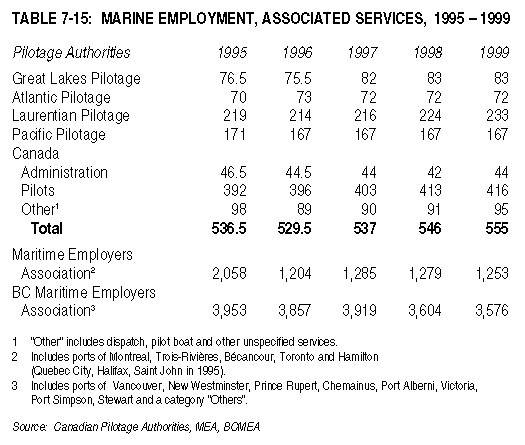
Maritime Employers Associations
The number of personnel associated with both the British Columbia
Maritime Employers Association (West Coast) and the Maritime
Employers Association (MEA) in Eastern Canada has decreased
since 1995. In the case of the MEA, a significant
proportion of the decline was due to a 1996 change in the composition
of ports that remained members of the organization.
Table 7-15 shows historical employment trends, by category,
for the two maritime employers associations in Canada.
Air
Travel Agencies, Tour Operators and Tour Wholesalers and Operators
Travel agencies, tour operators and tour wholesalers and operators
employed 31,174 people in 1999. This was a 2.7 per cent increase
over 1998 levels and a 15 per cent increase since 1990. Over 39
per cent of these workers were employed in Ontario. Personnel
in Quebec, British Columbia and Alberta accounted for 26,
16 and 10 per cent of the total, respectively.
Other Air-Related Associated Services
There are a number of personnel employed by associations related
to the air industry. These groups include the Air Transport
Association of Canada, the Northern Air Transport Association,
the Ultra Light Pilots Association of Canada, Canadian Owners
and Pilots Association and the Canadian Seaplane Association of
Canada. In addition, carrier and air navigation staffs are represented
by a number of unions, with administrative staff. It was not possible
to retrieve accurate employment counts for these services for
this issue of the report.
Workforce
NOTES
1
1998 is the most recent year for which this level of information
is available.
2
A large part of this decline occurred between 1993 and 1995 as
a result of the industry's labour reduction program, including
the sale of CN subsidiary AMF Technotransport, which had
previously been included in CN's Canadian Rail Operations.
3
Rail data in Table 7-1 includes Class III carriers and jobs related
to incidental services.
4
Includes all Canadian-domiciled for-hire companies that reported
$1 million or more in operating revenues for the year under consideration.
5
Small for-hire carriers include Canadian-based companies with
operating revenues greater than or equal to $30,000 and less than
$1 million. 1997 is the most current year for available data.
6
Data limited to Canadian-based carriers with annual operating
expenses of $1 million or more.
7
1997 is the most recent year for which data is available.
8
Threshold changes were made in the trucking surveys in 1990, therefore
the time-series shown starts at 1991.
9
Companies with annual revenues of $2 million or more.
10
There were 16 additional carriers with annual revenues between
$200,000 and $2 million that did not report employment data.
11
There were 13 additional carriers with annual revenues between
$200,000 and $2 million that did not report employment data.
12
There were 722 additional companies with annual revenues between
$200,000 and $2 million that did not report employment data.
13
There were 580 additional companies with annual revenues between
$200,000 and $2 million that did not report employment data.
14
Estimates for this sector have been included in the aggregate
figures for 1997, 1998 and 1999. Actual updated numbers will not
be available until the next Census in 2001.
15
Detailed carrier level employment data, as reported in the 1998
report, are no longer available.
16
Data for 1999 are not available at this level of disaggregation.
17
Intercity, school, charter and other, shuttle and urban transit
bus companies, with annual operating revenues greater than $2
million.
18
The number of taxi and limousine drivers discussed earlier has
been subtracted from the total number of "other" transportation
jobs recorded by Statistics Canada's Survey of Employment, Payrolls
and Hours.
19
Fraser River, Halifax, Hamilton, Montreal, Nanaimo, North Fraser,
Port Alberni, Prince Rupert, Quebec City, Saguenay, Saint John,
Sept-Îles, St. John's, Thunder Bay, Toronto, Trois-Rivières,
Vancouver, Windsor.
20
There are a number of non-CAA/LAA facilities for which employment
data is not available.
21
Transport Canada, Canadian Coast Guard/DFO, Transportation Safety
Board, Canadian Transportation Agency, Civil Aviation Tribunal.
22
The number of full-time positions, which does not necessarily
directly equate to the number of people in the positions.
|

